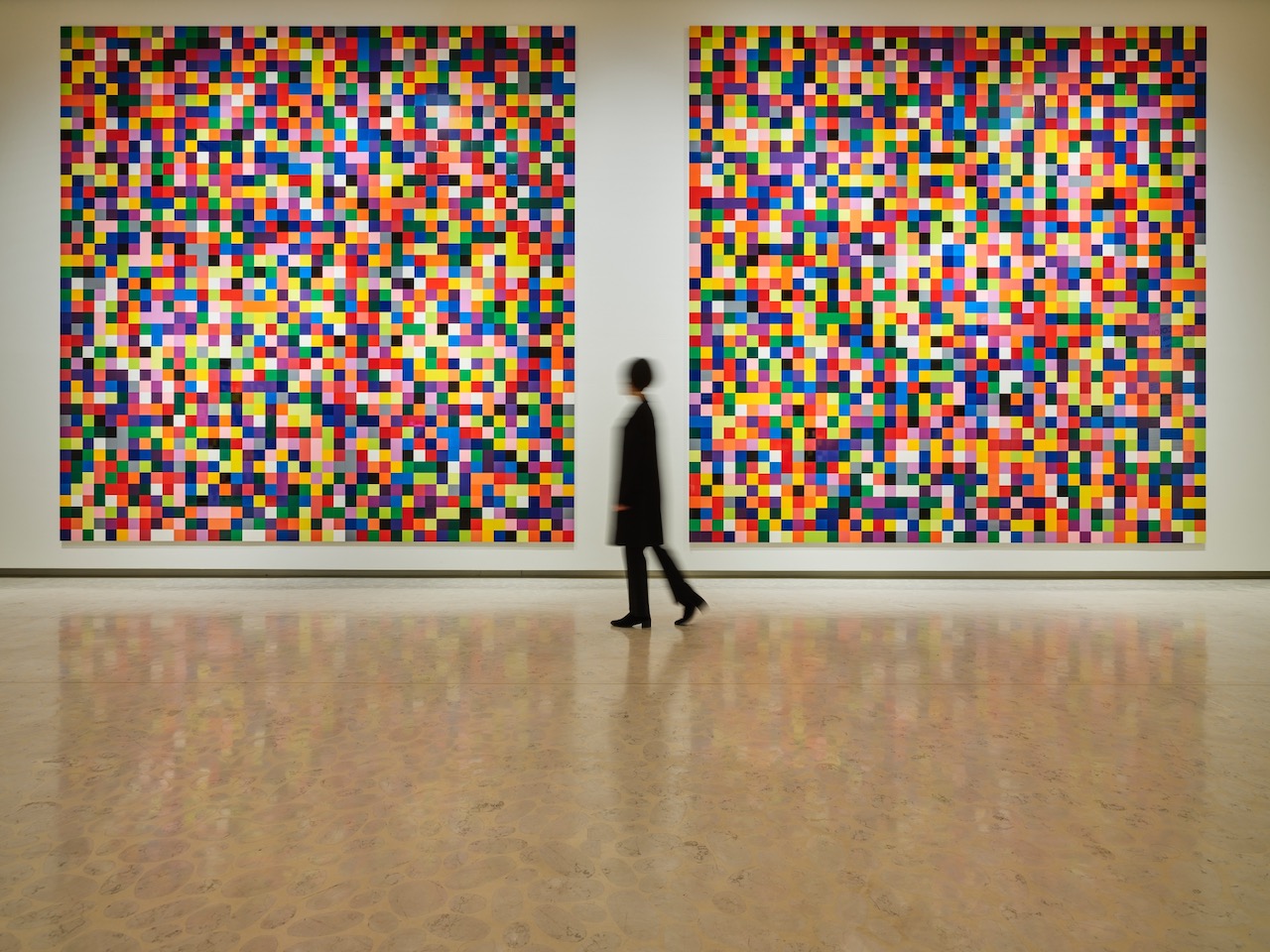
Gerhard Richter - the most expensive living artist in Europe (continuation)
ArtWizard 01.02.2024
Continuation of Gerhard Richter - the most expensive living artist in Europe
Cover photo of the article © Courtesy of the artist and Fondation Louis Vuitton
By the end of the 1970s a cycle of colourful abstract works was developed, signed simply Abstraktes Bild - 1, 2, 3, 4, 5. For a time the greys and browns in the artist's palette were replaced by bold and bright colours on different patterns, textures, surfaces and in a variety of techniques. They offered a vigorous exploration of optics and perception, planes, depth, space, form, colour and light. This was a significant stage in Richter's oeuvre and laid the foundations for future strands of work - series such as Sindbad (1, 2, 3, 4), Aladdin (1, 2, 3, 4) and Cage (1, 2, 3).
In 1971, ten years after his flight to West Germany and arrival in Düsseldorf, the Dresden-based artist was appointed professor of painting at the Kunstakademie Düsseldorf / Staatliche Kunstakademie Düsseldorf, from 1973 to 1977 Isa Genzken studied in Gerhard Richter's painting class, and from 1982 to 1993 the couple were married.
In the earliest drawing in the exhibition, Richter inserts a pencil into a drill to draw fine, rippling lines. The swirling motion creates contours reminiscent of flowers, especially rose petals. This drawing, different from the rest of Richter's work of the time, is completely abstract and focuses solely on the course of the line. By replacing his hand with a drill that draws the line on the paper, the artist deprived the work of his personal handwriting and left all the action to the machine. His ambivalent attitude towards craft and artistic "drawing skill" is vividly expressed here.
"I have never been an iconoclast, otherwise I wouldn't paint landscapes, portraits and the like. Rebellion is contrary to my temperament" says Gerhard Richter in a conversation with Götz Adriani in 2017. In retrospect, 1972 proves to be an intense and successful exhibition year for the artist: his photographic and source material was labelled Atlas. For the German pavilion at the 36th Venice Biennale, he painted a cycle of 48 Portraits (324/1-48) with images of famous people from the previous two centuries - scientists, composers, philosophers and writers - using encyclopaedia photographs as source material. For the first time in the history of this forum, an entire pavilion was given to one artist. He then devoted himself to seascapes in the style of the painting Caspar David Friedrich - Das Eismeer. At the same time, he again moved away from black and white photographic painting and tried painting landscapes with very broad brushes, the traces of which increase the degree of abstraction of the paintings and undermine their representational function.
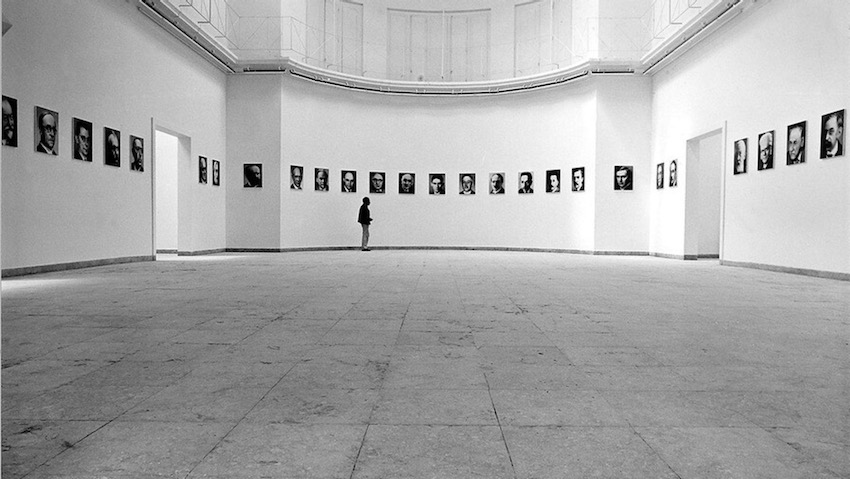
Gerhard Richter, 48 Portraits, 1972
Photo Credit: The official website of Gerhard Richter
Gerhard Richter's detachment from pictoriality was also confirmed in the colour panels, which he took up again in 1973 and in which he individually distributed 180 colour tones mixed from three primary colours and grey. On the one hand, the grid is reminiscent of colour panels from the paint industry, on the other hand the artist wanted the random distribution to be seen as a reaction to the seriousness of neo-constructivists such as Josef Albers.
"To be able to represent all the colour tones in a painting, I developed a system which, starting with the three primary colours plus grey, allowed me to break down (differentiate) the colours into increasingly regular steps. 4 x 4 = 16 x 4 = 64 x 4 = 256 x 4 = 1024. The number 4 as a multiplier was necessary because I wanted to keep a constant proportion between image size, field size and number of margins. Using more than 1024 colour tones (e.g., 4096) seemed pointless to me, as in this case the differences from one colour level to another would no longer be noticeable. The arrangement of colour tones in the margins is done randomly to achieve a diffuse, indifferent overall effect, while the detail can be stimulating. The rigid grid prevents figures from emerging, although with effort they become visible." - says Gerhard Richter in 1974.
In the summer of 1976, Richter turned once again to gestural abstraction and painted Konstruktion (389). In doing so, he embarked on a path that to this day makes him one of the most important abstractionist painters. They are distinguished from the abstractions of the 1980s by their comparatively small size. Starting in 1979, he used a scraper to create his abstractions, which were created layer by layer over a long period of time, with a dose of randomness. "Letting something emerge instead of creating it." - says Gerhard Richter in 1985.
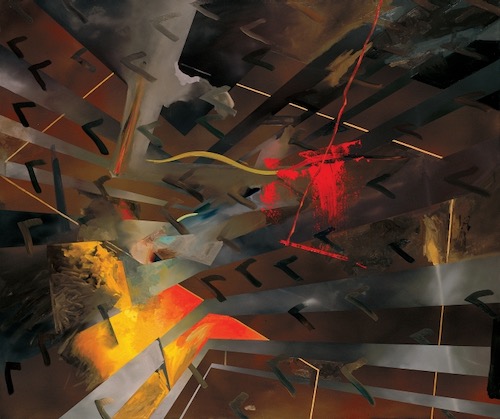
Gerhard Richter, Konstruktion, 1976
Photo Credit: The official website of Gerhard Richter
By the late 1980s, Richter had become one of the most prominent artists in Germany and the world. In 2002, the Museum of Modern Art, MoMA held a major retrospective of his work entitled "Forty Years of Painting". The exhibition included 190 works, one of the most comprehensive exhibitions of the artist to date.
As a kind of contrast to his abstract paintings, in 1982 and 1983 Gerhard Richter worked on images of candles and skulls, which in the mid-1980s became his trademark. Eventually, the American rock band Sonic Youth used the painting Kerze, 1983, as the cover of their 1988 album Daydream Nation. The painterly fragile candles and flames take on an almost mystical power due to the dark background and are painted in a masterful photorealistic manner. The artist often works with metaphors, including the burning candle, which symbolises contemplation, transience and death. By often adding a skull to the candle, he reinforces the association with transience. "But the oft-used theme of the candle has also become a political symbol in connection with the commemoration of the 50th anniversary of the destruction of Dresden. Candles have always been an important symbol for the GDR as a silent demonstration against the regime," Gerhard Richter explains the origin of the candle paintings. At the time, he did not realise that a popular dimension was simultaneously emerging from the discursive context. However, Richter calls this "a pleasant side effect of popularisation".
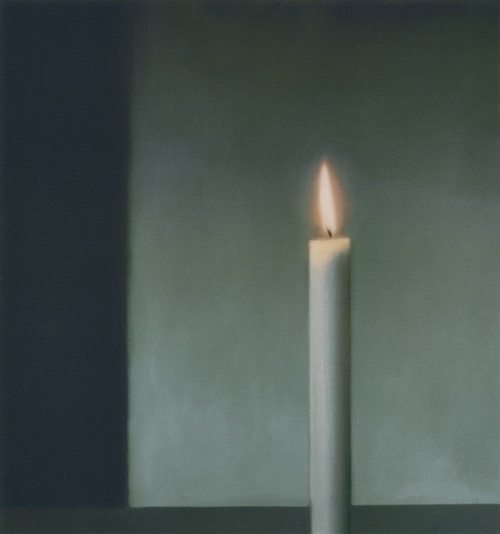
Gerhard Richter, Kerze, 1983
Photo Credit: The official website of Gerhard Richter
Although the burning candle, painted in the manner of the old master, is still one of the most popular motifs in Gerhard Richter's oeuvre today, his international breakthrough came in 1984 with large abstractions. In 1986, the first retrospective at the State Art Museum Düsseldorf / Städtische Kunsthalle Düsseldorf took place, which presented the largest exhibition of the artist's work with 133 pieces and travelled to Berlin, Bern and Vienna. The exhibition catalogue was conceived as the first electronic catalogue of the artist's work.
"Traditional, so-called old works of art are not old, but modern. As long as we 'have' them in the broadest sense of the word, they will never become obsolete, and we will not put something equal, equal or surpass them in quality next to them. Their constant presence necessitates another, today's, which is neither better nor worse, but must be different, because yesterday the Isenheimer Altar was written". - says Gerhard Richter in 1983.
The 15-part painting cycle 18. Oktober 1977 was created between March and November 1988 on the occasion of the suicide of members of the radical RAF / Red Army Faction in Stammheim and the culmination of the "German Autumn". Richter conducted research in the archives of the newspapers Stern and Spiegel in Hamburg. The cycle has been interpreted in various ways and is today seen, among others, as the culmination of the artist's fascination with historical representation in order to reveal traumatic collective experiences. As Richter himself noted, the cycle 18. Oktober 1977 completed his fascination with images based on black and white photographs from the 1960s. Since 1993, Gerhard Richter's painting Betty (663-5), painted by Gerhard Richter as a rear view following a snapshot of his eponymous daughter from his first marriage, has been interpreted as a positive analogue to the RAF cycle. "By viewing the painting in this way, I am not trying to do anything other than bring together the most different and contradictory things in as free a form as possible in a living and viable way. No paradises." - Gerhard Richter, 1986.
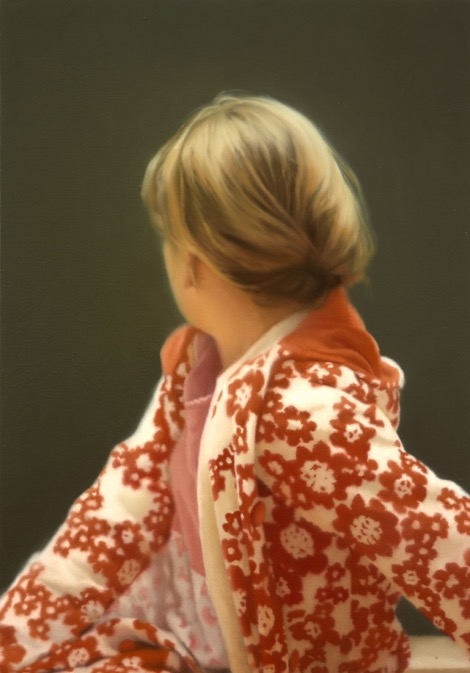
Gerhard Richter, Betty, 1988
Photo Credit: The official website of Gerhard Richter
Gerhard Richter is an atheist who came out of the Protestant Church. In 2006, he was able to demonstrate his "penchant for Catholicism" in a stained-glass window on the façade of the south transept of Cologne Cathedral / Kölner Doms. The 106 square metre stained-glass window consists of 11'263 mouth-blown squares of genuine antique glass measuring 9.6 by 9.6 cm, in 72 different colours. The abstract composition of the colour field is conceptually derived from the painting 4096 Farben, 1974. The production costs of Derix Glasstudios totalled 370'000 euros, but the artist donated his work to the cathedral, in the form of donations. After the inauguration on 25 August 2007, there were both positive and critical voices.

Gerhard Richter, 4096 Farben, 1974
Photo Credit: The official website of Gerhard Richter
The reason for the divided reception was the genesis of Richter's cathedral window. The 1863 glazing, donated by the Prussian royal house, was destroyed along with the designs during World War II. Subsequently, the Chapter of Cologne Cathedral planned to commemorate the martyrs of the 20th century (Edith Stein, Maximilian Kolbe) and the Holocaust. The architect of the cathedral personally approached Gerhard Richter with a request for a different design. This option impressed him more than the figurative designs of Egbert Verbeek and Manfred Hürlimann, who, however, followed the guidelines.
For his abstract project Gerhard Richter cut out a photograph of the painting 4096 Farben and pasted it behind the tracery windows. In 2005, the artist was commissioned to continue working on this concept and the work was finally completed in 2006. From a palette of 800 colours, Richter selected 72 shades, which were also used in 19th century windows. A random number generator was responsible for the sequence, although the trajectories were mirrored (1-3, 2-5, 4-6). The artist only took corrective action if the coloured panels randomly created a shape. Because the coloured panels were attached to the support disc with silicone, Richter could work without lead rods.

Gerhard Richter, Kölner Domfenster, 2007
Photo Credit: The official website of Gerhard Richter
In the 1980s and 1990s Gerhard Richter worked mainly with drawing and watercolours. Abstract works on paper allowed him to overcome stylistic fixations and frozen ideas, to make the contradictory visible. In doing so, he used various techniques that went beyond the conventions of classical watercolour. The juxtaposition of conscious intent and uncontrolled events created sheets of mesmerising density and vividness that could not be achieved in the same way on canvas with oil paint. In the face of the amazing, aesthetically stunning results, the artist often questioned the seriousness of these works. Thus, in 1997 he completed his last cycle of watercolours, and in 1999 he supposedly ended this genre with a series of pencil drawings.
In the following years Gerhard Richter concentrated entirely on painting, and only in his later creative years did he unexpectedly turn to works on paper again. After completing a large abstract painting, he decided to give up painting for good in 2017, but at the end of the year he started painting again. Richter still spent the day in the studio at his usual pace, but instead of working on the wall, he now laboured at his desk. His working method remained the same: painting was never continuous, it always took a certain amount of time. Intense weeks were followed by longer breaks, which the artist filled with other activities. This was also the case with his works on paper. Since in each case he dated them precisely, it is obvious that they were created over a period of days or weeks, depending on mood and concentration. Richter soon went beyond drawing in pencil and used oil crayons and paints to give the work an added impetus. He exhibited these sheets repeatedly, and although on each occasion he stated that these were his last works, they were followed a few months later by others. Gerhard Richter's latest work is a cycle of 31 small-format abstract works on paper he created between 5 and 11 January 2022, as well as 31 of their photographs in an edition titled mood.
